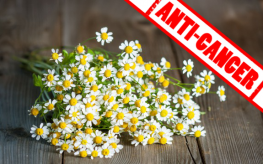Compound in this Herb Beats Cancer, FDA Fast Tracks its Use for Big Pharma Meds

An herb discussed below caused a big upset a few years back when researchers realized it could be more successful at killing cancerous cells than an expensive chemo drug. Since that discovery, the Food and Drug Administration (FDA) has fast-tracked the plant compounds to be used in pharmaceutical meds. Want to know how to get yours from the natural source without paying Big Pharma for their patents? Read on.
Feverfew (tanacetum parthenium), also known as wild chamomile, is no small herb. Its properties are so powerful it has been shown to outperform anti-leukemia chemo drugs. The active ingredient in feverfew, which is responsible for much of its healing power, is known as Parthenolide.
Until recently, feverfew was used by herbalists primarily as a treatment for migraine headaches and nausea, but it turns out that the extent of its true healing powers were being overlooked.
One abstract concluded:
“It has multiple pharmacologic properties, such as anticancer, anti-inflammatory, cardiotonic, antispasmodic, an emmenagogue, and as an enema for worms. In this review, we have explored the various dimensions of the feverfew plant and compiled its vast pharmacologic applications to comprehend and synthesize the subject of its potential image of multipurpose medicinal agent. The plant is widely cultivated to large regions of the world and its importance as a medicinal plant is growing substantially with increasing and stronger reports in support of its multifarious therapeutic uses.”
Parthenolide has shown great promise in treating multiple cancers, though admittedly not in human testing. It works by reducing the spread (metastasis) or the recurrence of several types of cancerous cells, including breast, prostate, lung, bladder, leukemia, and myeloma.
Good News: Blushwood Berries Kill Cancer Fast – Big Pharma Tackles Patent
Another study, published in the Journal of Experimental & Clinical Cancer Research, concluded:
“The parthenolide can inhibit the cell growth, migration, and induce the apoptosis in human pancreatic cancer. These findings may provide a novel approach for pancreatic cancer treatment.”
Harikrishna Nakshatri, associate professor of surgery, biochemistry, and molecular biology, and Marian J. Morrison, an investigator in breast cancer research, has discovered that parthenolide could block the activity of a protein called NF-kB in breast cancer cells. NF-kB promotes the production of proteins that block cell death. In moderation, that’s a good thing, but when NF-kB becomes overactive, cancer cells become resistant to chemotherapy drugs.
Fortunately, the active feverfew compound, parthenolide, is not highly soluble in water, which makes it harder for pharmaceutical companies to extract the compound and patent it. They have to modify its structure slightly for it to still work to kill cancerous cells. But you could also just take the much less expensive herb, and get the compound as nature intended it. Feverfew can also be grown in your own garden, and you can take the herb to induce cancer cell apoptosis for pennies.
“When once planted it [feverfew] gives year after year an abundant supply of blossoms with only the merest degree of attention.”
I’m quite certain the American Medical Association and American Cancer Society wouldn’t want you to know that.
Additional Sources:

